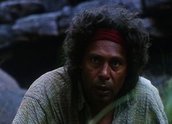


Dead Heart (1996)
Synopsis
When a young aboriginal man is found hanging in a police cell, Senior Constable Ray Larkin (Bryan Brown) allows his own deputy (Lafe Charlton) to be speared as payback. The tiny settlement of Wala Wala is soon in uproar again when a young black man (Aaron Pedersen) is killed for desecrating a man’s ceremonial ground. Larkin suspects the death was ordered by Poppy (Gnarnayarrahe Waitairie), a senior man who resents the policeman’s power. Larkin arrests Tjulpu (Djunawong Stanley Mirindo), a 'bush black’ who speaks no English. In the pandemonium that follows, Lutheran pastor David (Ernie Dingo) is forced to choose sides, as a handful of white residents cower in their homes.
Curator’s notes
Dead Heart offers a much more nuanced and pessimistic view of black-white relations than most films on that subject, and a more contemporary one. It shows a community that’s not really a community at all as it falls apart. Policeman Ray Larkin is a second generation Northern Territory cop who prides himself on his even-handed, culturally aware approach, but he is caught up in a power struggle over whose law is supreme – white fella or black fella law.
The old man Poppy appears to be a scheming troublemaker who’s on the make, but he’s also trying to protect his culture. There are divisions within both black and white parts of this place, and anyone trying to bridge them gets hurt – Tony (Aaron Pederson) gets killed for taking his lover Kate (Angie Milliken) to a sacred place; the pastor David (Ernie Dingo) is forced to commit a crime by elders wanting to test his tribal loyalty; Larkin is almost killed then removed in disgrace by his supervisors. Wala Wala is finally abandoned by both blacks and whites, as a failed experiment, and the film offers a cynical coda, in which Poppy is shown driving off in to the desert in a brand new Toyota, which he has probably paid for with a bribe from the television journalists. The attempt to live together and understand each other in this case ends in disaster, death and disgrace.
Nick Parsons conceived the story as a film originally, then turned it into a play, which was performed in Sydney and Perth in 1993 and 1994. Bryan Brown was also the producer, and he gives one of his finest performances as Ray Larkin, a flawed man trying to do his best. Indeed, Parsons gets great performances from all his actors, although a few of the characters are underdeveloped.
The film gives a troubling but credible picture of the tensions within outback communities. It goes far beyond the usual simplistic explanations of 'too much grog and too much violence’, to look at deeper causes – but it offers no solutions other than to abandon these blighted places.
Secondary curator’s notes
by Romaine MoretonDead Heart attempts to culturally analyse the social and political dynamics of an Indigenous community and the white characters that exist within it. The Western characters are very much central to this narrative, and the Indigenous characters personify and or symbolise the white angst of living in the desert region – depicted as a formidable and inhospitable place. The spiritual and mystical component of Indigenous culture literally haunts the white characters, and the dark mystery of the land itself – being uninhabitable and uncivilised – is extended to include the Indigenous people, and is the theme of this film.
The openly racist dialogue spoken by the characters interrupts the humanisation of the Indigenous characters, and instead the audience is encouraged to identify with the white anxiety as these characters essentially attempt to civilise the Aboriginal people as well as the land. The young person who sniffs petrol for example, does not have a name, but is merely known as 'Petrol Sniffer’. The Indigenous people and land are judged harshly in this film and exemplified by the film’s title Dead Heart referring to the land. The same land in Indigenous cultural context is not a dead heart, but the heart of the Dreaming. It is this paradoxical view of country expressed by Indigenous and Western people, which establishes the dramatic tension in this film that is ultimately expressed as racial tension.
- Overview
- Curator’s notes
- Video 3 clips
- Principal credits
- Find a copy
- Make a comment
- Map
- Add your review




